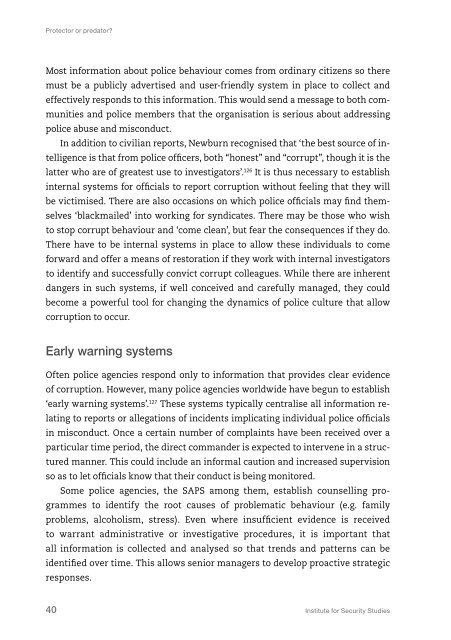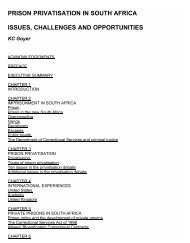Protector or predator? - Institute for Security Studies
Protector or predator? - Institute for Security Studies
Protector or predator? - Institute for Security Studies
Create successful ePaper yourself
Turn your PDF publications into a flip-book with our unique Google optimized e-Paper software.
<strong>Protect<strong>or</strong></strong> <strong>or</strong> predat<strong>or</strong>?<br />
Most inf<strong>or</strong>mation about police behaviour comes from <strong>or</strong>dinary citizens so there<br />
must be a publicly advertised and user-friendly system in place to collect and<br />
effectively responds to this inf<strong>or</strong>mation. This would send a message to both communities<br />
and police members that the <strong>or</strong>ganisation is serious about addressing<br />
police abuse and misconduct.<br />
In addition to civilian rep<strong>or</strong>ts, Newburn recognised that ‘the best source of intelligence<br />
is that from police officers, both “honest” and “c<strong>or</strong>rupt”, though it is the<br />
latter who are of greatest use to investigat<strong>or</strong>s’. 126 It is thus necessary to establish<br />
internal systems f<strong>or</strong> officials to rep<strong>or</strong>t c<strong>or</strong>ruption without feeling that they will<br />
be victimised. There are also occasions on which police officials may find themselves<br />
‘blackmailed’ into w<strong>or</strong>king f<strong>or</strong> syndicates. There may be those who wish<br />
to stop c<strong>or</strong>rupt behaviour and ‘come clean’, but fear the consequences if they do.<br />
There have to be internal systems in place to allow these individuals to come<br />
f<strong>or</strong>ward and offer a means of rest<strong>or</strong>ation if they w<strong>or</strong>k with internal investigat<strong>or</strong>s<br />
to identify and successfully convict c<strong>or</strong>rupt colleagues. While there are inherent<br />
dangers in such systems, if well conceived and carefully managed, they could<br />
become a powerful tool f<strong>or</strong> changing the dynamics of police culture that allow<br />
c<strong>or</strong>ruption to occur.<br />
Early warning systems<br />
Often police agencies respond only to inf<strong>or</strong>mation that provides clear evidence<br />
of c<strong>or</strong>ruption. However, many police agencies w<strong>or</strong>ldwide have begun to establish<br />
‘early warning systems’. 127 These systems typically centralise all inf<strong>or</strong>mation relating<br />
to rep<strong>or</strong>ts <strong>or</strong> allegations of incidents implicating individual police officials<br />
in misconduct. Once a certain number of complaints have been received over a<br />
particular time period, the direct commander is expected to intervene in a structured<br />
manner. This could include an inf<strong>or</strong>mal caution and increased supervision<br />
so as to let officials know that their conduct is being monit<strong>or</strong>ed.<br />
Some police agencies, the SAPS among them, establish counselling programmes<br />
to identify the root causes of problematic behaviour (e.g. family<br />
problems, alcoholism, stress). Even where insufficient evidence is received<br />
to warrant administrative <strong>or</strong> investigative procedures, it is imp<strong>or</strong>tant that<br />
all inf<strong>or</strong>mation is collected and analysed so that trends and patterns can be<br />
identified over time. This allows seni<strong>or</strong> managers to develop proactive strategic<br />
responses.<br />
40<br />
<strong>Institute</strong> f<strong>or</strong> <strong>Security</strong> <strong>Studies</strong>

















